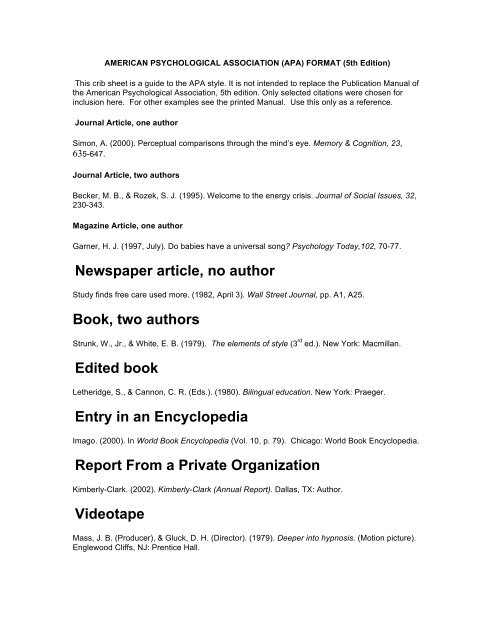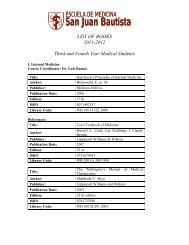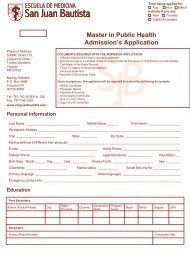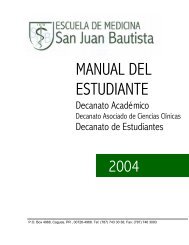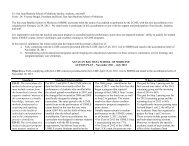American Psychological Association (APA) - San Juan Bautista ...
American Psychological Association (APA) - San Juan Bautista ...
American Psychological Association (APA) - San Juan Bautista ...
Create successful ePaper yourself
Turn your PDF publications into a flip-book with our unique Google optimized e-Paper software.
AMERICAN PSYCHOLOGICAL ASSOCIATION (<strong>APA</strong>) FORMAT (5th Edition)<br />
This crib sheet is a guide to the <strong>APA</strong> style. It is not intended to replace the Publication Manual of<br />
the <strong>American</strong> <strong>Psychological</strong> <strong>Association</strong>, 5th edition. Only selected citations were chosen for<br />
inclusion here. For other examples see the printed Manual. Use this only as a reference.<br />
Journal Article, one author<br />
Simon, A. (2000). Perceptual comparisons through the mind’s eye. Memory & Cognition, 23,<br />
635-647.<br />
Journal Article, two authors<br />
Becker, M. B., & Rozek, S. J. (1995). Welcome to the energy crisis. Journal of Social Issues, 32,<br />
230-343.<br />
Magazine Article, one author<br />
Garner, H. J. (1997, July). Do babies have a universal song? Psychology Today,102, 70-77.<br />
Newspaper article, no author<br />
Study finds free care used more. (1982, April 3). Wall Street Journal, pp. A1, A25.<br />
Book, two authors<br />
Strunk, W., Jr., & White, E. B. (1979). The elements of style (3 rd ed.). New York: Macmillan.<br />
Edited book<br />
Letheridge, S., & Cannon, C. R. (Eds.). (1980). Bilingual education. New York: Praeger.<br />
Entry in an Encyclopedia<br />
Imago. (2000). In World Book Encyclopedia (Vol. 10, p. 79). Chicago: World Book Encyclopedia.<br />
Report From a Private Organization<br />
Kimberly-Clark. (2002). Kimberly-Clark (Annual Report). Dallas, TX: Author.<br />
Videotape<br />
Mass, J. B. (Producer), & Gluck, D. H. (Director). (1979). Deeper into hypnosis. (Motion picture).<br />
Englewood Cliffs, NJ: Prentice Hall.
Electronic Formats<br />
Internet Article Based on Print Source<br />
The citation is done as if it were a paper article and then followed by a retrieval<br />
statement that identifies the date retrieved and source.<br />
Sahelian, R. (1999, January). Achoo! Better Nutrition, 61, 24. Retrieved September 17, 2001,<br />
from Academic Index.<br />
Web page, no author, no date<br />
GVU’s 8 th WWW user survey. (n.d.). Retrieved September 19, 2001, from<br />
http://www.cc.gatech.edu/gvu/user_surveys/survey-1997-10/<br />
Chapter or Section in an Internet Document<br />
Thompson, G. (2003). Youth coach handbook. In Joe soccer. Retrieved September 17, 2001<br />
from http://www.joesoccer.com/menu.html<br />
Web page, Government author<br />
Wisconsin Department of Natural Resources. (2001, March 14). Glacial<br />
habitat restoration areas.<br />
Retrieved September 18, 2001<br />
from http://www.dnr.state.wi.us/org/land/wildlife/hunt/hra.htm<br />
Company Information from Aggregated Database<br />
Ripon Pickle Company Inc. (company profile). (2003). Retrieved September 18, 2002 from<br />
Business and Company Resource Center.<br />
Personal Communications<br />
Personal communications may be things such as email messages, interviews,<br />
speeches, and telephone conversations.<br />
Because the information is not retrievable they should not appear in the<br />
reference list. They should look as follows: Example: J. Burnitz (personal<br />
communications, September 20, 2000).
Reference Citations in Text<br />
To refer to an item in the list of references from the text an author-date method should be used.<br />
That is, use the surname of the author (without suffixes) and the year of the publication in the text<br />
at appropriate points.<br />
One author<br />
Issac (2001) indicated in his research..<br />
In a recent study, research indicates (Isaac, 2001)<br />
Two or more authors<br />
When a work has two authors, always cite both names every time the reference occurs. For<br />
works with three, four, or five authors, cite all authors the first time the reference occurs. In<br />
subsequent citations, include only the last name of the first author followed by et al.<br />
When a work has no authors<br />
Cite in text the first few words of what appears first for the entry on the list (usually the title) and<br />
the year.<br />
Specific parts of a source<br />
(Yount & Molitor, 1982, p. 19)<br />
(Cooper, 1983, chap. 4)<br />
Works with no author<br />
(“New Student Center,” 2002)<br />
Some general rules for <strong>APA</strong> reference pages:<br />
• Begin the reference list on a new page. The page begins with the word References (Reference if there is only<br />
one), centered in the top, middle of the page, using both upper and lower case. If the references take up more<br />
than one page, do not re-type the word References on sequential pages, simply continue your list.<br />
• Use one space after all punctuation.<br />
• The first line of the reference is flush left. Lines thereafter are indented as a group, a few spaces, to create a<br />
hanging indention.<br />
• Double space between citations. Single space in the citations.<br />
• Use italics for titles of books, newspapers, magazines, and journals.<br />
• References cited in text must appear in the reference list; conversely, each entry in the reference list must be<br />
cited in text.<br />
• Arrange entries in alphabetical order<br />
• Give in parentheses the year the work was published. For magazines and newspapers, give the year followed<br />
by the month and date, if any. If no date is available, write n.d.<br />
• Give volume numbers for magazines, journals, and newsletters. Include the issue number for journals if and<br />
only if each issue begins on page 1.


